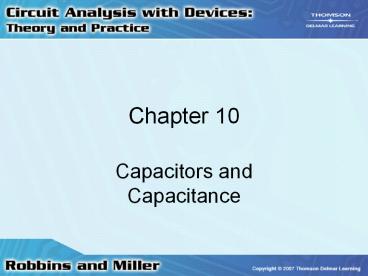Capacitors and Capacitance - PowerPoint PPT Presentation
Title:
Capacitors and Capacitance
Description:
Chapter 10 Capacitors and Capacitance Capacitance Capacitor Stores charge Two conductive plates separated by insulator Insulating material called dielectric ... – PowerPoint PPT presentation
Number of Views:126
Avg rating:3.0/5.0
Title: Capacitors and Capacitance
1
Chapter 10
- Capacitors and Capacitance
2
Capacitance
- Capacitor
- Stores charge
- Two conductive plates separated by insulator
- Insulating material called dielectric
- Conductive plates can become charged with
opposite charges
3
Definition of Capacitance
- Amount of charge Q that a capacitor can store
depends on applied voltage - Relationship between charge and voltage given by
- Q CV or C Q/V (Similar to Ohms Law)
4
Definition of Capacitance
- C is capacitance of the capacitor
- Unit is the farad (F)
- Capacitance of a capacitor
- One farad if it stores one coulomb of charge
- When the voltage across its terminals is one volt
5
Effect of Area
- Capacitance is directly proportional to amount of
charge - Larger plate will be able to hold more charge
6
Effect of Area
- Capacitance is directly proportional to plate
area - If plate area is doubled, capacitance is doubled
7
Effect of Spacing
- As plates are moved closer together
- Force of attraction between opposite charges is
greater - Capacitance
- Inversely proportional to distance between plates
8
Effect of Spacing
- Double the distance between plates
- Capacitance becomes half as much
9
Effect of Dielectric
- If a dielectric other than air is used between
the plates - More charge can build up on the plates
- The factor by which the capacitance increases
- Dielectric constant or the relative permittivity
10
Effect of Dielectric
- Permittivity
- How easy it is to establish electric flux in a
material - Represented by e (Greek letter epsilon)
11
Capacitance of a Parallel-Plate Capacitor
- Directly proportional to plate area
- Inversely proportional to plate separation
- Dependent on dielectric
- A farad is a very large unit
12
Electric Flux
- Electric fields
- Force fields in region surrounding charged bodies
- Direction of this field is direction of force on
a positive test charge - Field lines never cross
13
Electric Flux
- Density of lines indicate field strength
- Electric field lines are indicated by ? (Greek
letter psi)
14
Electric Fields
- Strength of an electric field is force that
field exerts on a small test charge - E F/Q
- Electric flux density total flux/area
- D ?/A
15
Electric Fields
- Flux is due to the charge Q
- The number of flux lines coming from a charge is
equal to the charge itself - ? Q
16
Field of a Parallel-Plate Capacitor
- To move a charge from the negative plate to the
positive plate requires work - Work Force distance
- Voltage Work/charge
- E V/d
17
Field of a Parallel-Plate Capacitor
- Electric field strength between plates
- Equal to voltage between them
- Divided by distance between them
18
Voltage Breakdown
- If voltage is increased enough, dielectric breaks
down - This is dielectric strength or breakdown voltage
19
Voltage Breakdown
- Breakdown can occur in any type of apparatus
where insulation is stressed - Capacitors are rated for maximum operating voltage
20
Nonideal Effects
- Leakage current
- Equivalent Series Resistance
- Dielectric Absorption
- Temperature Coefficient
21
Fixed Capacitors
- Ceramic Capacitors
- Values change little with temperature, voltage,
or aging - Plastic Film Capacitors
- Mica Capacitors
- Low cost, low leakage, good stability
22
Fixed Capacitors
- Electrolytic Capacitors
- Large capacitance at low cost
- Polarized
- Surface Mount Capacitors
23
Variable Capacitors
- Used to tune a radio
- Stationary plates and movable plates
- Combined and mounted on a shaft
- A trimmer or padder capacitor is used to make
fine adjustments on a circuit
24
Capacitors in Parallel
- Total charge on capacitors is sum of all charges
- Q CV
- CTE C1V1 C2V2 C3V3
- All voltages are equal
25
Capacitors in Parallel
- CT C1 C2 C3
- Total capacitance of capacitors in parallel
- Sum of their capacitances (like resistors in
series)
26
Capacitors in Series
- Same charge appears on all capacitors
- Total V
- Sum of individual voltages (like resistors in
parallel)
27
Capacitors in Series
28
Capacitor Voltage
- Voltage across a capacitor does not change
instantaneously - Voltage begins at zero and gradually climbs to
full voltage
29
Capacitor Voltage
- Full voltage is source voltage
- May range from nanoseconds to milliseconds
- Depending on the resistance and capacitance
30
Capacitor Current
- During charging
- Electrons move from one plate to another
- Current lasts only until capacitor is charged
31
Capacitor Current
- Current
- Large initial spike to zero
- No current passes through dielectric
32
Energy Stored in a Capacitor
- A capacitor does not dissipate power
- When power is transferred to a capacitor
- Stored as energy
33
Capacitor Failures and Troubleshooting
- Reasons for capacitors failure
- Excessive voltage, current, or temperature, or
aging - Test with an ohmmeter
- Good capacitor will read low, then gradually
increase to infinity
34
Capacitor Failures and Troubleshooting
- Capacitor short
- Meter resistance will stay low
35
Capacitor Failures and Troubleshooting
- If capacitor is leaky
- Reading will be lower than normal
- If open
- Stays at infinity































